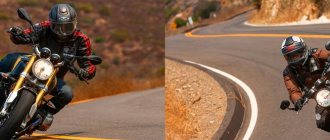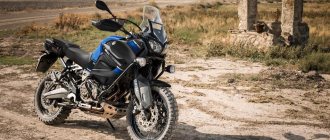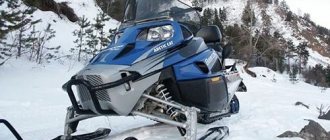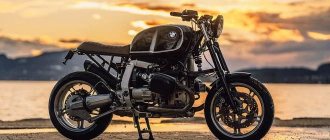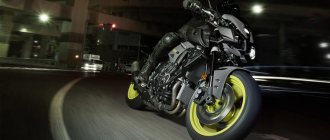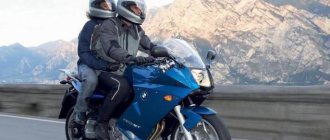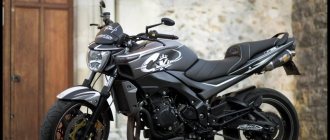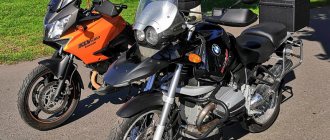2019 KTM 350 EXC-F vs. KTM 500 EXC-F Comparison Test
We had the opportunity to do a comparison test between the 2021 KTM 350 EXC-F and KTM 500 EXC-F.
Both bikes received some changes this year, such as stiffer fork tuning, updated stanchion pistons, revised rear shock settings, a new lithium-ion starter battery, re-upholstered seats, new graphics and a frame color change from black to orange.
Before the test
Before the test, we installed road tires on the rear wheels and put both bikes on the dyno. The KTM 350 EXC-F produced 34.74 hp. at 8840 rpm and 30.4 Nm of torque at 7250 rpm, while the KTM 500 EXC-F gained 41 hp. at 7800 rpm and 40 Nm of torque at 6690 rpm. We then installed a new set of Metzeler 6 Days Extreme mud tires to even out the off-road capabilities of both bikes.
Engine
The KTM 350 EXC-F pulls poorly from low end, but reveals itself at medium and high speeds. The KTM 500 EXC-F engine has high torque over a wider rpm range , pulls better from low end and is very good in the mid to high rpm range. Technical sections of the trail require the KTM 350 EXC-F to operate the clutch frequently, while the KTM 500 EXC-F engine performs better on such sections due to its ability to pull from lower revs. As a result, the “small” engine feels at home on long high-speed sections thanks to higher revs and maximum output at the top. The KTM 350 EXC-F will appeal more to aggressive riders.
The hydraulically operated Brembo clutch works flawlessly - it engages smoothly without much effort on the lever, and can be adjusted without tools. The six-speed gearboxes on both bikes are very user-friendly with well-chosen ratios. First gear is very low and it feels like you are riding a trial bike. Second gear is also quite low, but third gear is suitable for smoother and faster sections. Fourth, fifth and sixth gears are suitable for high-speed sections and highways.
KTM 350 EXC-F and KTM 500 EXC-F 2019
Romanian surprise
I have been to the presentation of new off-road products from KTM more than once and I can confidently say that hardly any of the competitors treats the organization of such events with the same care and love as the friendly and enthusiastic team of like-minded people from Mattighofen. Probably the fact is that there are absolutely no strangers in it - absolutely all the employees are “sick” of off-road motorcycles! Just imagine: employees of the PR and advertising departments, mechanics and secretaries, heavy-duty vehicle drivers and even photographers have a very good command of off-road driving techniques. It is unlikely that you will find such unanimity in any other motorcycle company! This is probably why presentations of KTM motorcycles are organized in the most interesting and unexpected places: here you will find the rocky slopes of the Apennines of the world famous Hells Gate race, and the Catalan cliffs surrounding the Principality of Andorra, and deserted Moroccan routes, and the environs of the legendary Udevalla cross-country track filled with northern swamp slurry. ... But for the presentation of the new generation of EXC series motorcycles, in my opinion, the most suitable place for this action was chosen. The equipment had to be tested in the mountains of Transylvania overgrown with dense impenetrable forest, on the slopes of which a bone-crushing hard enduro rally has been held for more than ten years - the legendary Red Bull Romaniacs!
And to make the immersion into the atmosphere of the race as authentic as possible, the main conductor and guide was invited to be the founding father of the Romanian legend himself, the “great and terrible” Martin Freinademetz. I admit frankly - I haven’t felt such tension in all the muscles of my body for a long time... After yet another assault on the obstacles that athletes competing in the Expert class have to overcome, both my hands and my left leg cramped from tension. No, the muscles weren’t just simply sore - the fingers and lower limb were twisted and jammed so that staying on the motorcycle turned out to be quite a difficult task! We had to literally wade through completely impenetrable thickets of thorny acacia and storm the slopes along the beds of dried-up streams covered with pebbles, go down wet and slippery basalt steps on nameless mountain rivers and, using only muscular strength, carry motorcycles through huge multi-meter gaps overgrown with centuries-old pine trees... In In general, I was able to evaluate certain off-road qualities of Austrian enduros literally “in my own skin”!
Suspension
Both EXC-Fs are equipped with WP Xplor 48mm forks and WP Xplor PDS shock absorbers. The forks perform excellent at low speeds and absorb small obstacles such as rocks, logs and other uneven surfaces well. Since the forks are tuned for dual-sport and are comparatively softer than motocross or off-road, we were impressed by their decent power delivery on high-speed and high-elevation sections. The rear PDS shock absorbers maintain traction surprisingly well. On trails strewn with obstacles, the rear wheel stays glued to the ground and doesn't tend to bounce or veer, making it easy to stay on track on technical sections.
Why?
It's no secret that sports enduros are the most popular and dynamically developing class of off-road motorcycles today. After all, fans of free “three-dimensional” movement in space on all continents of our planet are becoming more and more from year to year, sales figures for equipment are constantly growing, and the number of participants in the most difficult professional and amateur enduro races is increasing exponentially. What is there! The humorous saying “Everyone will ride an enduro” has long become an unspoken and informal slogan for hundreds of thousands of people who can no longer imagine themselves without the opportunity to ride a motorcycle off public roads. However, despite the dynamics of the development of the sports enduro market, Japanese manufacturers continue to ignore this very profitable and promising segment. Why? For me personally, this is a mystery! In the extensive model range of any player of the big Japanese four, as a rule, there are only two or three off-road motorcycles. And if cross-country models are as technologically advanced and modern as possible, then one gets the feeling that enduros are designed and produced according to some flawed, residual principle. Another thing is the profile technology of the Old World. In the absence of real competition over the past decades, the cult of dual-purpose motorcycles has bloomed wildly in European territories. It was here that, at the end of the 20th century, a huge variety of models and manufacturers appeared, concentrated in a relatively small area. Who hasn't produced equipment of this class! Honored and legendary BSA, Husqvarna, Husaberg, CZ and exotic for our country Bultaco, Ossa and TM... Famous BMW, Gas Gas, Sherco or Simson, Zundapp, Puch or Hercules that have already become history... Well, and, of course, the main trendsetters in off-road motorcycle fashion of recent years - the Austrians from the KTM company. Nowadays, orange motorcycles have acquired the status of a cultural and technical cult, which even the most brand-dependent motorcycle maniac is unlikely to argue with. And no wonder - after all, it is the engineers from Mattighofen who come up with the most progressive and unexpected technical solutions when designing motorcycles. And the end result is quite obvious: almost complete dominance in the European and American markets - and this position was strengthened even more after the launch of the well-deserved off-road fighters in the form of Husaberg and its successor Husqvarna.
Frame and handling
With years of motocross and off-road experience transferred to dual-sport motorcycles, KTMs are great to ride. Our bikes have a 2.5 kg difference in weight: the KTM 350 EXC-F weighs 115.6 kg and the KTM 500 EXC-F 117 kg, this is noticeable on technical slow sections where the KTM 350 EXC-F is easier to maneuver. As speed increases, the difference in weight between both motorcycles disappears. On the straights both bikes are stable and predictable. The Brembo brakes are powerful and responsive. The KTM EXC-F is quite thin at the front and rear, but wider than the 2021 SX-F and XC-F in the radiator and license plate areas. The pilot's position is classic, the seats are comfortable, which allows you to ride all day without getting tired.
Disclaimer: the author is not a real endurist. There are few skills, the pace is very slow (largely due to the previous point). Therefore, it is better to read what is written below in the format “the owner of the elephants bought the first hardendura”, and not as a full-fledged review. And, yes, of course, they told me that 500 cubic meters is a lot for a beginner, it will tear off my arms, run over me, and further in the text (if you also want to tell me about this, I won’t mind arguing with you). 
I also deeply apologize for the quality of the photos - for obvious reasons, I don’t carry a DSLR on such trips; at best, the photos are not taken with a phone.
Background.
In 2014, the idea that I needed two motorcycles finally broke through from drafts into reality. For Slonyara (KTM 990 Adventure) a lighter 690 Enduro was purchased. I wrote a separate post about this motorcycle, so I won’t repeat myself. It was a good experience on the topic of “something lighter than a touring bike,” but it showed that I don’t really like touring on a light motorcycle, and apart from that in the forest, the 690 didn’t seem light enough. If so, it made sense to study another segment. And just then my friends began to massively sell their Africans/Tigers/Jebels/etc. and I realized that this was a sign. Of course, I left the elephant in the garage, but I had to say goodbye to the 690.
So, we’re buying a hard-endura, it turns out. There was no question with the manufacturer: there were already two KTMs, so there will be a third. With the number of strokes, everything was also clear: the very fact of switching to engine hours caused me some noticeable concerns, and I was not at all ready for stress in the form of mixture/resonance and all this (although later I rode a little on the two-stroke EXC250 and They seemed very, very interesting to me, but still not for my purposes).
The main issue is volume. In fact, everything was quite simple here too. The most common and, it seems to me, logical choice for a beginner is a check. But I, as a person who came from the asphalt, wanted something strange and, of course, I’m not talking about “less than a liter is for girls.” I wanted two things: even more adventures on my ass, resources and tractor traction. After consulting with a friend who owns EXC525, I went to AdvRider and there I studied a huge thread on the topic of what EXC525 is (the grandfather of the 500, but 530 and 500 were also discussed there, emnip), as well as a couple of other smaller ones , in order to re-ensure that this is exactly what I want. It turned out that people even manage to do off-road long-distance rides on large-capacity EXCs (the guys from the movie MotoNomad 2 are one of them, by the way). As for traction, everyone unanimously promised that, among other things, the tractor would be very nimble. 
Next, it's time to get to the motorcycle and look at it. I went to a manager from BC, already familiar from previous motorcycles, and he told me everything in detail and showed me everything (at the same time showing the 1290 Super Adventure, but that’s a different story). I wanted to make the replacement as quickly as possible, but my 690, as luck would have it, was selling very slowly. During this time, two PTS options that I was aiming for disappeared - there was one more left, in the form of Husky FE501 (which is the same thing), but there was a man riding it in SuMo and I somehow tensed up and decided that if says “don’t do it” in advance - this is a good reason not to do it, although the price tag was quite pleasant, as far as I remember.
Time passed, the Viking Rally was approaching, the loot was burning in my pocket... having run over the toad, I went to the usual orange motorcycle store.
TTX
Let me briefly tell you what the KTM EXC500 is. If we talk about appearance, then this is... an ordinary endura orange: a skinny, tall, like a fence, motorcycle with chopped forms of impact-resistant plastic.
It has the largest engine in the line: a four-valve single-shaft injection single-barrel with a volume of 510 cubic meters. There is both kick and electric start. Lubrication - two oil pumps. Clutch release is hydraulic.
The frame is a chrome-moly duplex with a separate tail. A tank with a volume of 9 liters is placed on top of it.
WP suspensions with a full range of adjustments. At the front there is a 48 mm fork with 300 mm travel, at the rear there is a shock absorber with 335 travel without a lever. Thanks to them, the moped has almost 35 cm of clearance under the belly, and 97 cm of height in the saddle.
The brakes (as well as the clutch hydraulics) are from Brembo. At the front there is a 260 mm disc with a two-piston caliper, at the rear there is a single-piston caliper on a 220 mm disc.
All this stuff weighs 111 kg without fuel. Independent measurements on stands show about 50 hp. and 48 nm on the wheel. It seems to me that at such a weight this is a very, very good indicator.
Gurneys.
The run-in took place on the asphalt and the moped was lightly pressed there (do not ride on sidewalks in industrial areas if there are adjacent ones ahead) - fortunately, only my self-esteem suffered.
The next meeting took place at the Viking Rally 2021. My friend takes my moped out of the trailer and hands it to me so that I can ride at least a little on the ground before the start. With the usual (990) movements, I rev up the engine a little and set off with the clear intention of quickly rushing into the distance, but something goes wrong - the rear wheel begins to dig an anti-tank ditch in the moss, the front wheel begins to break away from this very moss... I, in turn, I’m trying to put the moped back on two wheels. This incident taught me to be more attentive to the throttle and almost no such problems arose anymore.
In fact, from the very first meters it became clear that he was not evil at all - just powerful. Yes, if you are careless with the throttle in the first two or three gears, most likely your wheelie riding experience will be very useful. Otherwise, the large engine gives the motorcycle excellent elasticity with excellent response to the handle from almost any position. It does not have a hole in the idle area and it spins very willingly, in other words, it will smoothly drag you from below and vigorously accelerate from any speed. The only thing is that when driving for a long time at low speed, you will often hear the fan. By the way, I don’t have exact figures for consumption (due to refills from a canister and different coatings/modes), but a fifteen-liter tank seems to last forever.
The weight is also immediately felt and is definitely the best thing that has ever happened to me - this is my first bike that I can call really light and at the same time be honest with myself. Even with the Acerbis tank installed (which, among other things, provides additional protection for the radiators), the difference in weight between the 500 and 690 feels about the same as between the 690 and 990. This shows in everything from taxiing to when the bike needs to be removed from somewhere. . But a couple of times I was able to glue the motorcycle to its belly with the crankcase protection, having previously sunk it up to the hub in a piece of shit (the rear wheel traditionally rested on a buried log, and I discovered this too late) and I could no longer quickly get it out myself - friends came to the rescue.
Probably the most difficult thing in the process of riding such a motorcycle is to convince yourself that “yes, this is also possible” - to break habits and do what seemed unnatural on a motorcycle weighing two hundredweight and try something new.
The 500 has excellent handling, which, coupled with low weight and geometric cross-country ability, initially causes a break in the pattern - for example, in a few sessions, my “stenophobia”, which arose when it was necessary to drive in a very limited space (for example, along a narrow edge), almost disappeared - so dramatically The accuracy of control has changed (both when necessary to carefully drive through the tight end of the plug, and when shifting at higher speeds). I was pleasantly surprised that the motorcycle feels good on high-speed grader straights, it feels at least no worse than the 690 (although I expected that the loss in weight would significantly aggravate the instability of the motorcycle, as was the case when changing from 990 to 690).
The suspension works great - it soaks up bumps of any scale (and relative to the reports of elephants, this is a much smaller exaggeration), and the rest of the time it creates very comfortable conditions for those who are too lazy to constantly drive standing up. Compared to heavier equipment, the chassis seems omnipotent. I'm afraid I don't have enough skills for a more detailed description. )
As for the brakes - at times the front contour even seems excessively sharp - it, like the gas handle, took some getting used to at first. This may be due to the fact that due to the twofold difference in weight, the motorcycle has become more sensitive to locking the front wheel.
In general, I have no complaints about the ergonomics of the motorcycle - I can tolerate daylight hours while driving completely normally. The saddle is extremely narrow, there is zero wind protection, instead of a tidy there is a display from a calculator, but this is not at all annoying.
A noticeable downgrade relative to the 690/990 can probably be called only in the lowered waterline (in both previous motorcycles, air was taken from the spine of the frame, and in the case of the EXC - through the air vent, which is located below the saddle.
Service.
Ancient proverbs hint to us in every possible way that everything good has to be paid for. I now have a very modest mileage of about 380 km (we’re talking only about the ground), during which I have accumulated about 14 engine hours - last year I went out only twice (not counting break-in), but this year I came to my senses and in the first two months I clocked up so much the same as for the whole of last year.
If we round up, then one mile in my mode is about 30 km. Standard maintenance occurs every 15 hours (450 km), every 30 (many people here say that in semi-tourist mode, which I profess in every possible way, you can use the marks 45 or even 60) - a large maintenance with valve adjustment, but I still have time to far. It makes sense to service the air vent somewhat more often - I lubricate it once every 5-7 engine hours, since it is reusable.
Every 45 km, the manual recommends maintenance of the suspension, and once every 135 (4000 km) - maintenance of the engine. In the case of the latter, the public from AdvRider claims that the safety margin of the EXC 5xx family is enough for several hundred hours before capitalization in light mode. So, for example, one of the owners of the 2013 EXC500 cited the following numbers: at the time of writing the post, the engine had covered 502 hours and 11,000 miles (17,700 km), the engine was opened at 11,000 km to replace the piston and incidentally troubleshoot, after which it was reassembled the same form (except for the piston) - the condition was so good that he does not plan to re-open the crankcase at the next piston replacement and intends to repeat the opening closer to the 20,000 mile mark (32,000 km).
In general, the motorcycle has an open design and for many jobs you only need to jack it up, removing the saddle and tank.
Results.
When I bought this motorcycle, I was not entirely sure whether my expectations would be met, but in the end the five hundred turned out to be exactly what I wanted - a light and very fun dirt bike, with a powerful (but at the same time predictable) engine (and, I hope, a good resource :)), which became a portal to a completely different motorcycling. After Viking Rally 2021, I realized that the world has changed and is unlikely to be the same - no matter how cool and frisky the 990 is outside the asphalt compared to its competitors, but the thought that “there is no more intoxication of those days” is firmly stuck in my head - Unpaved episodes on trips, of course, remained, but the old enthusiasm for “going downhill just for the sake of getting downhill” in relation to heavy motorcycles was no longer there.

